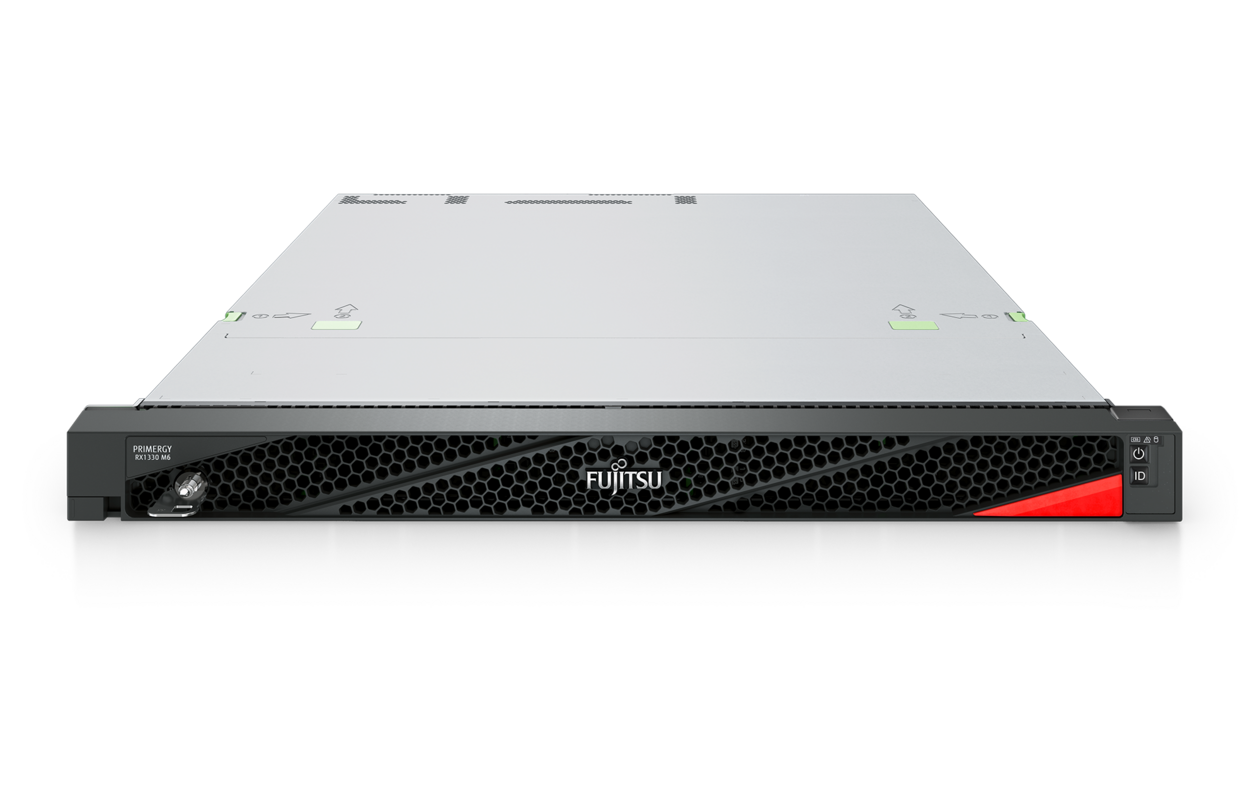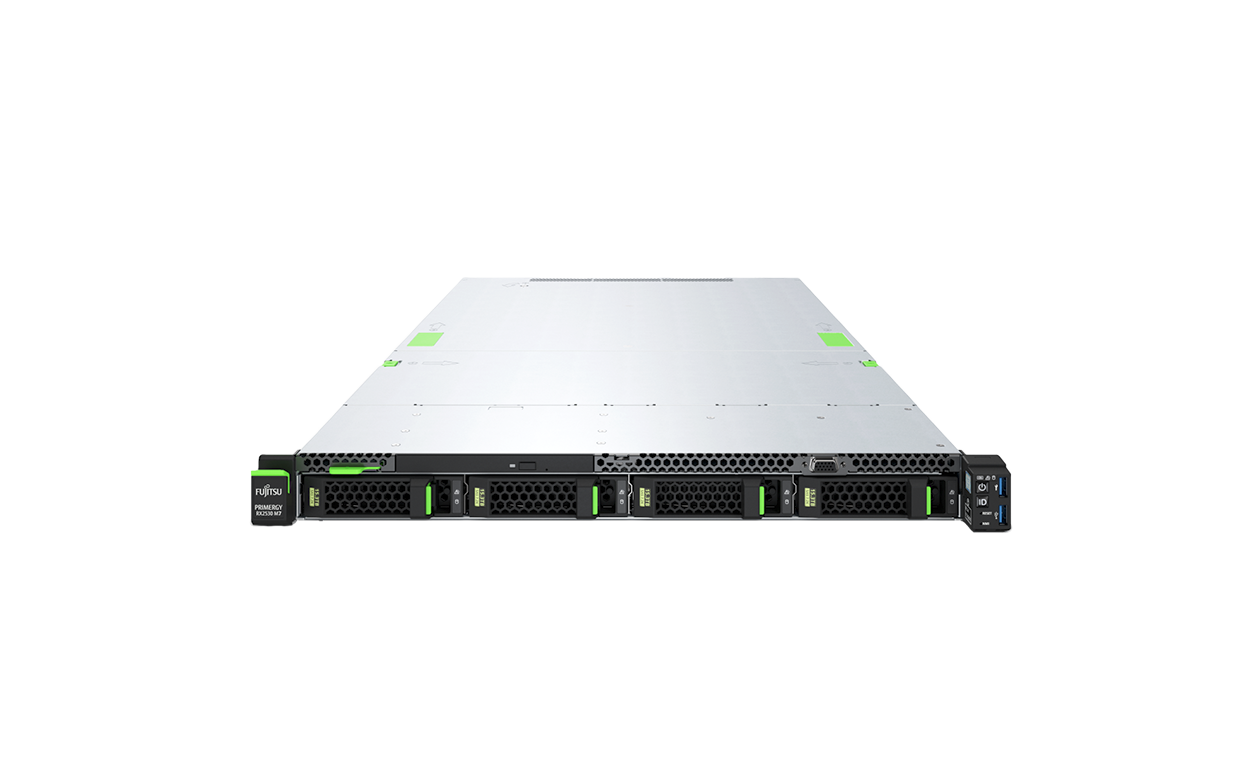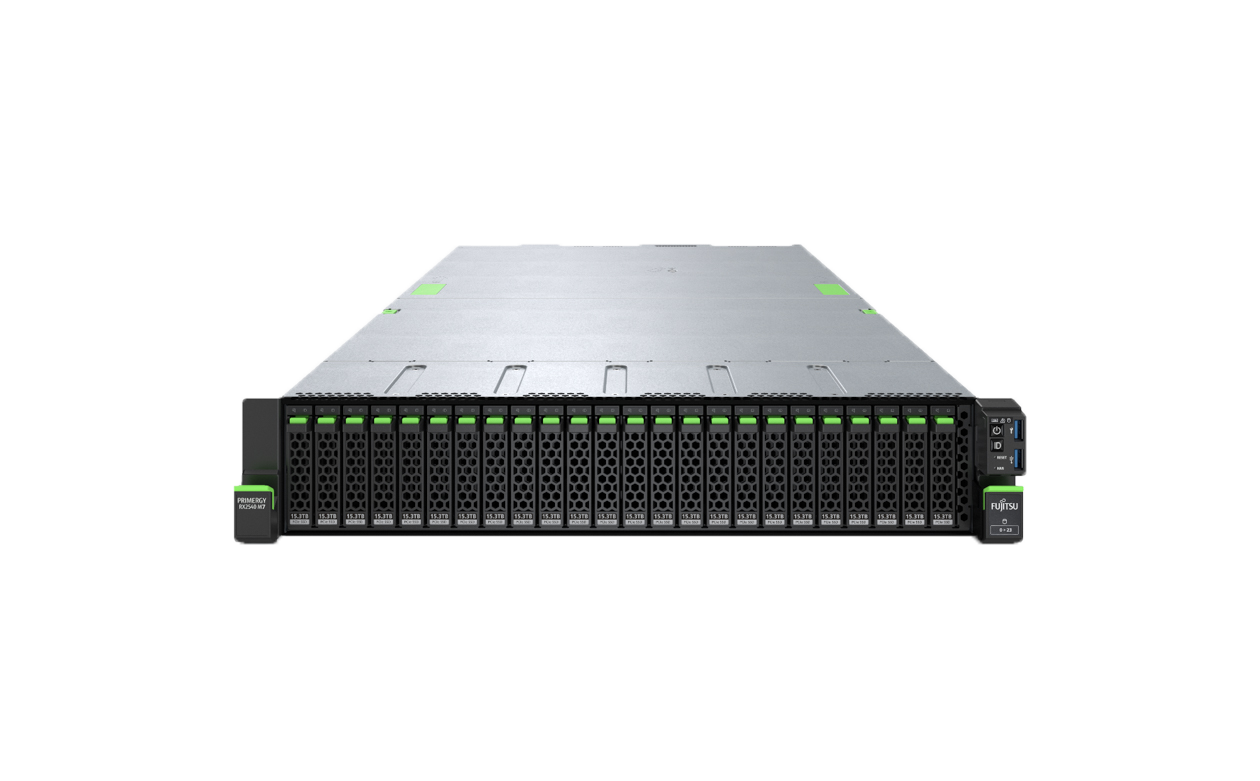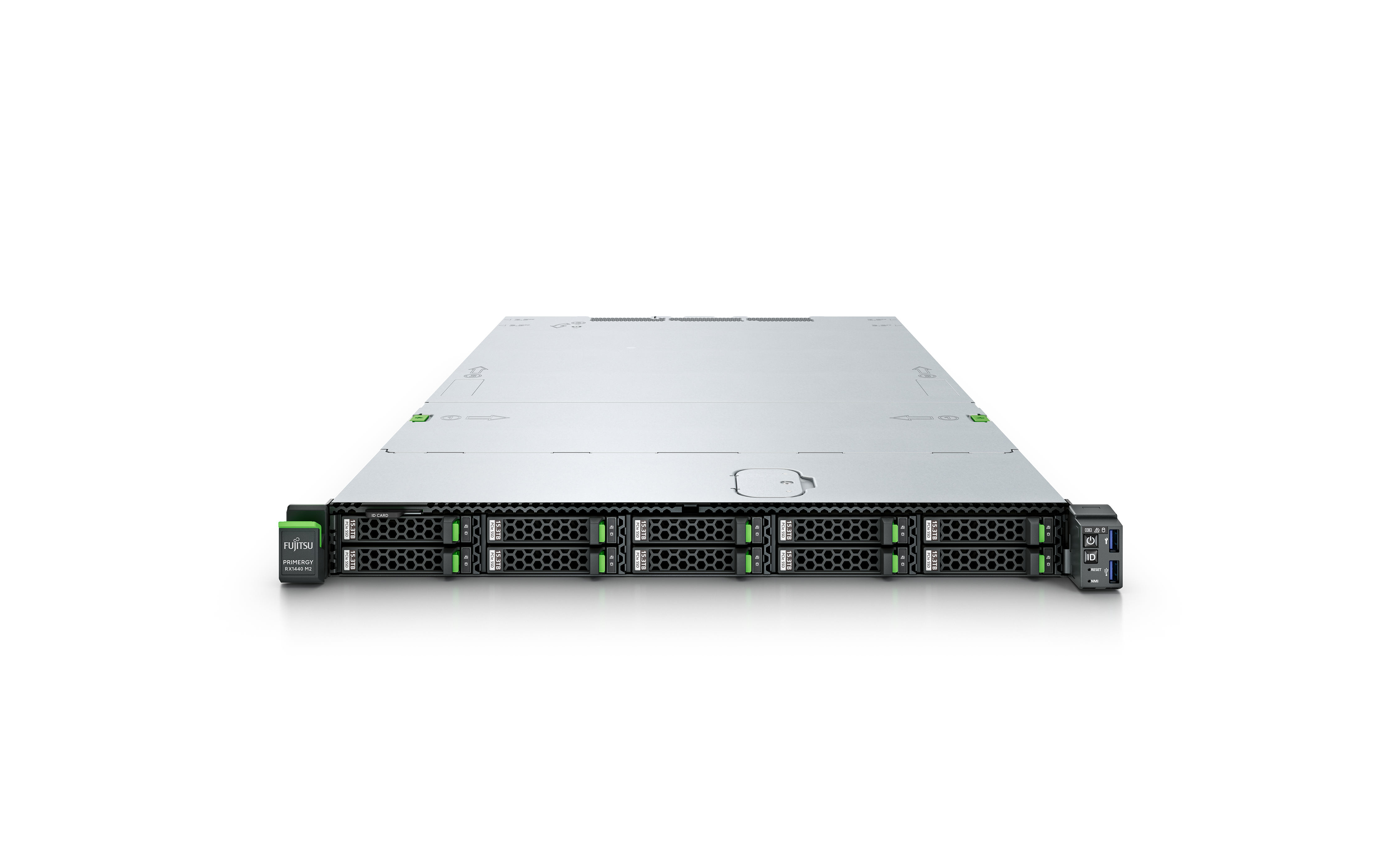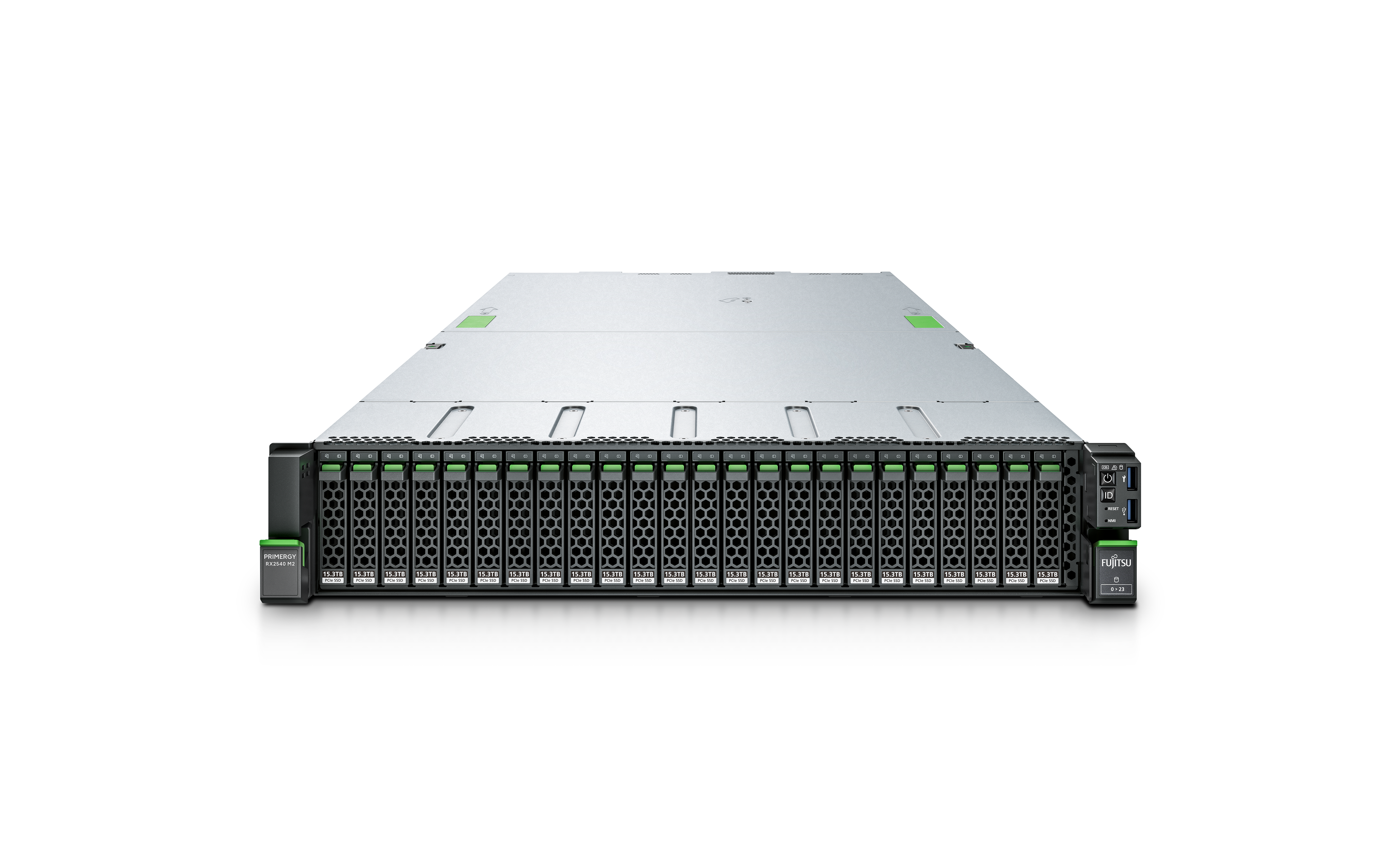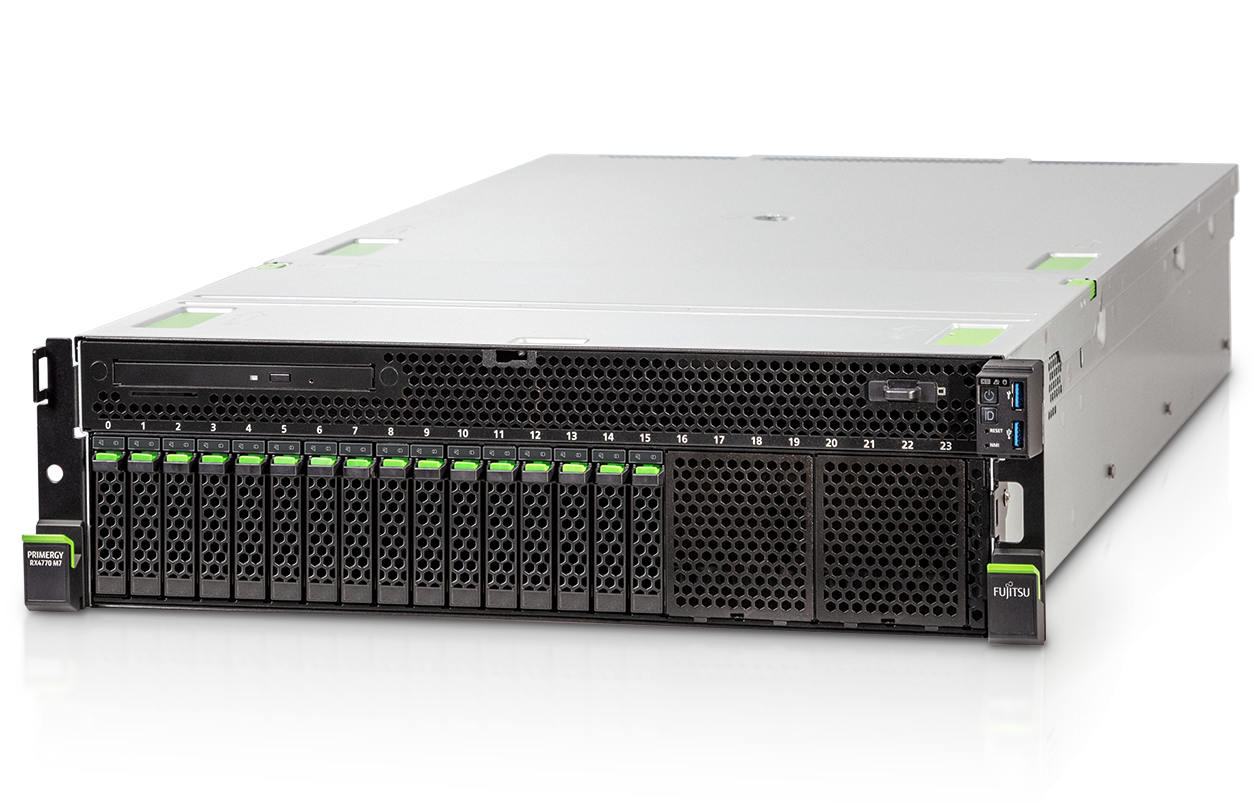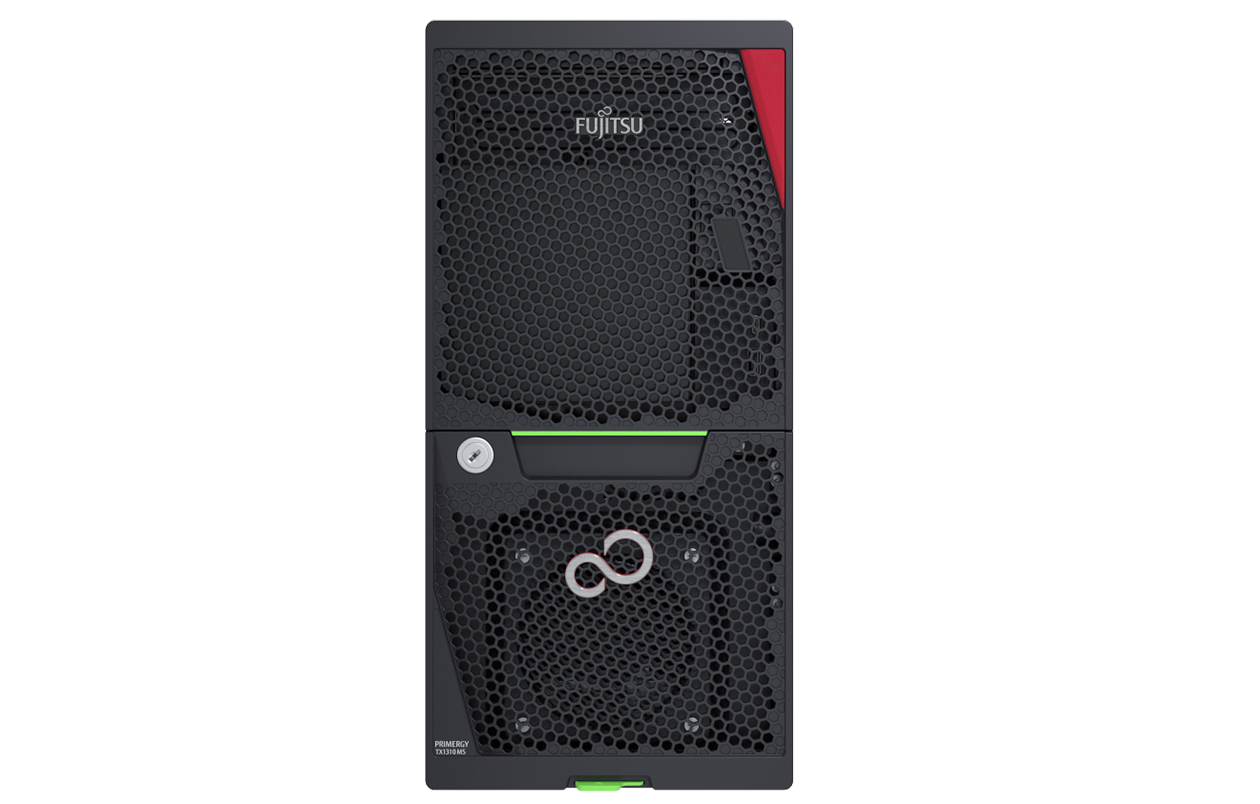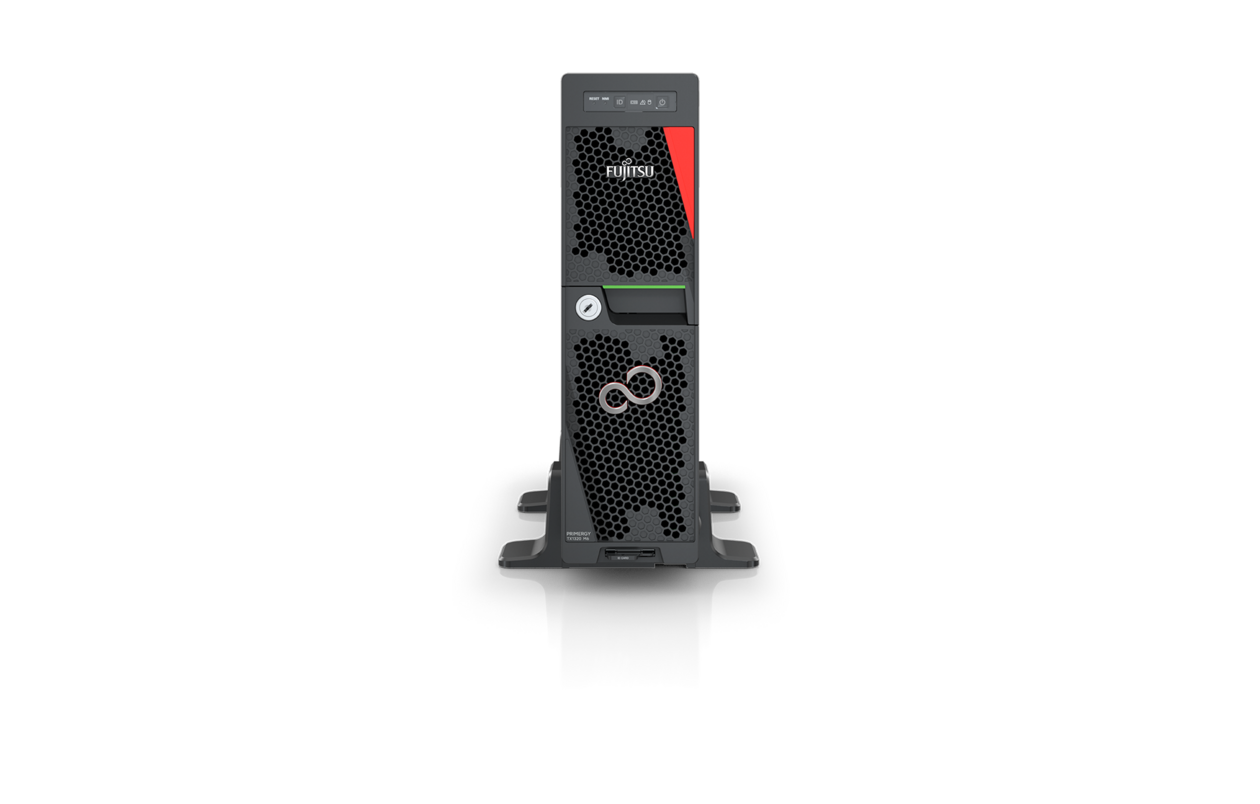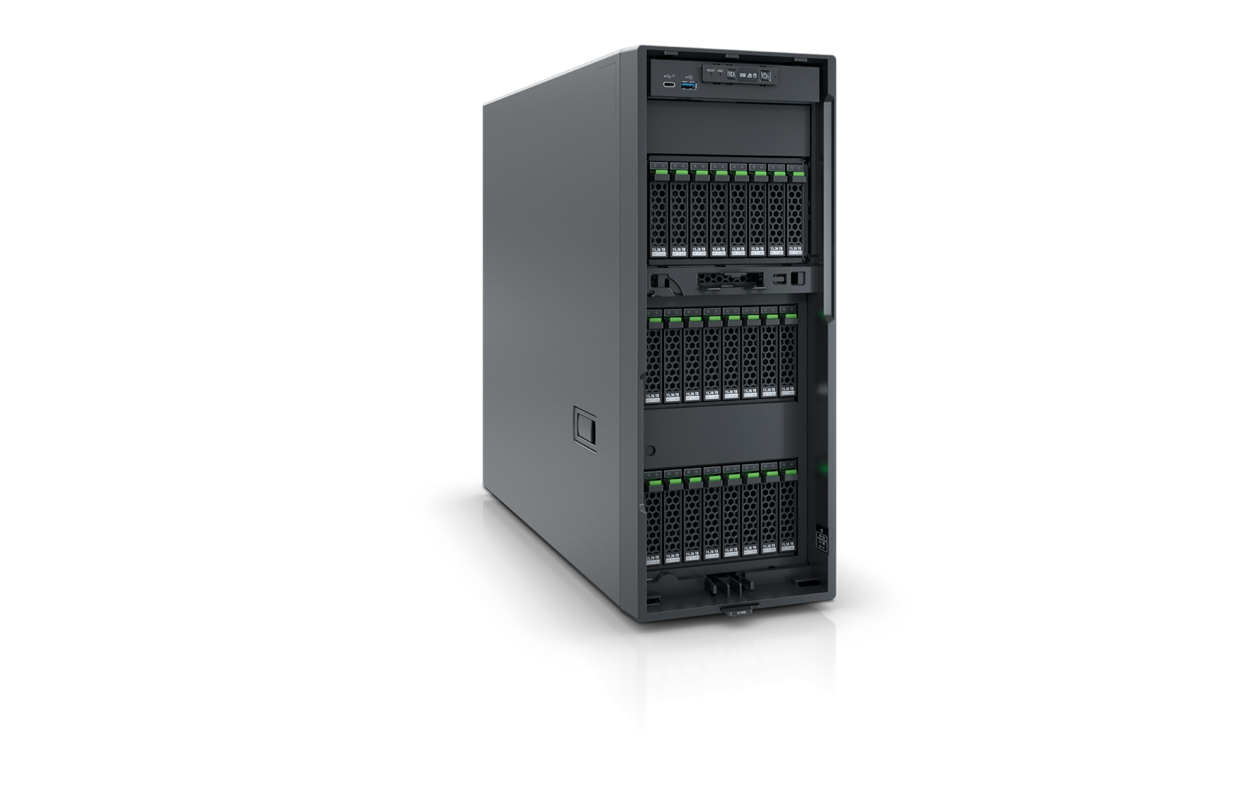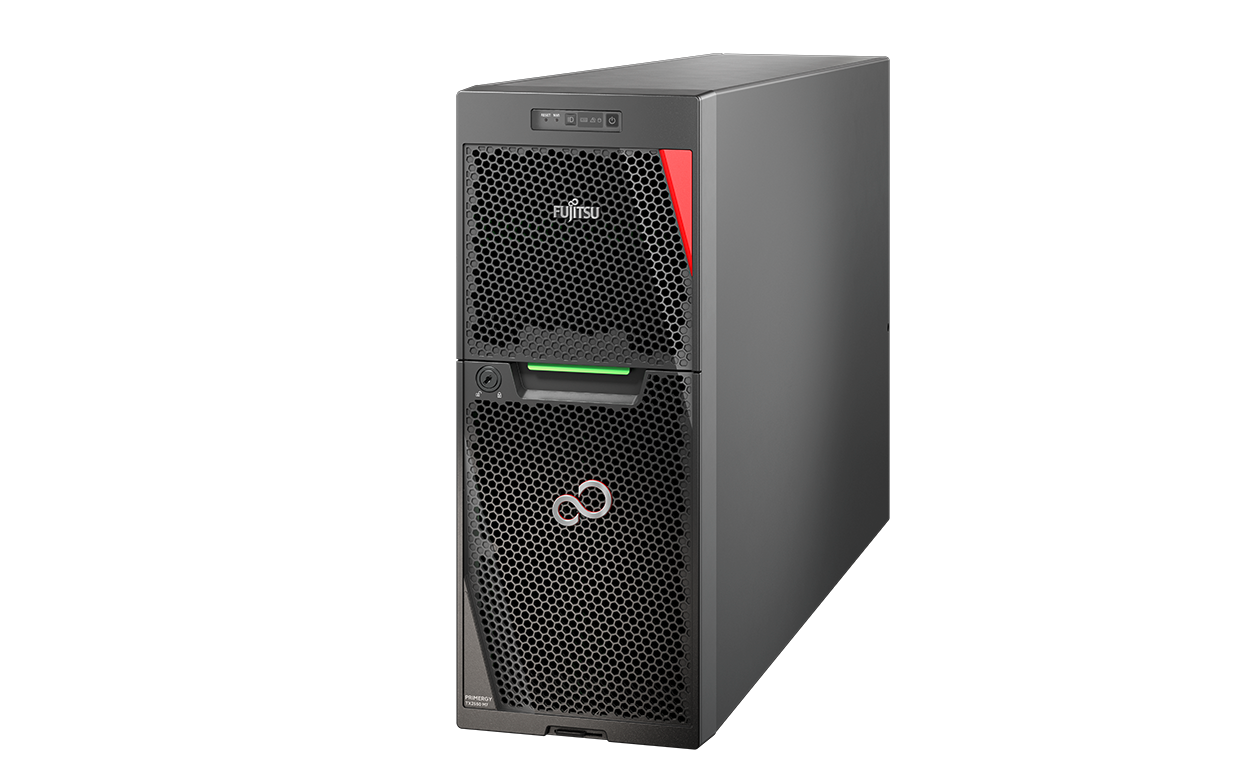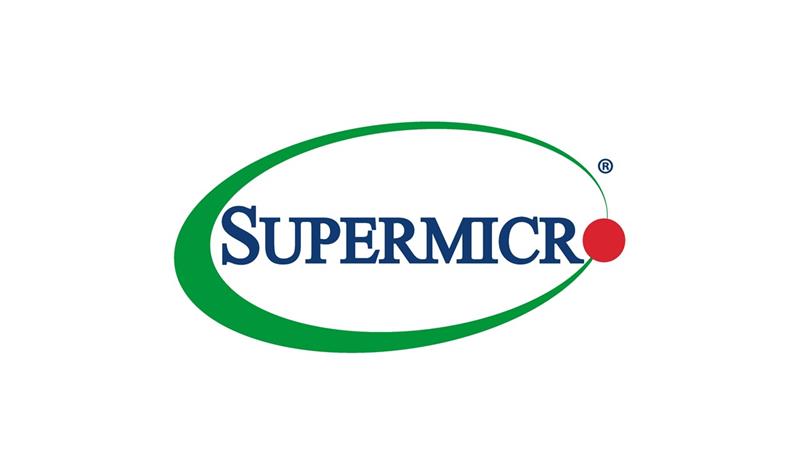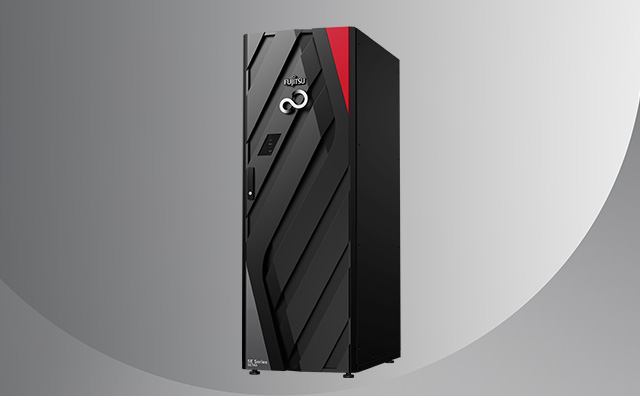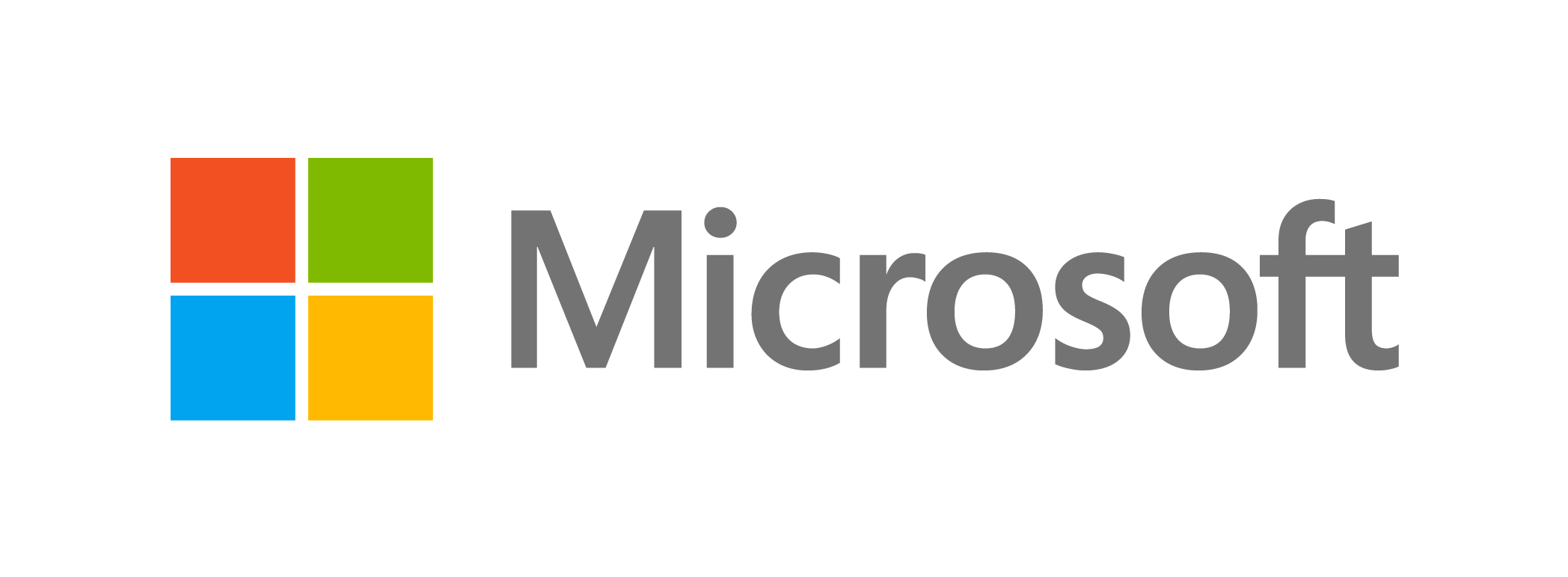Servers for the data-driven world
PRIMERGY Servers
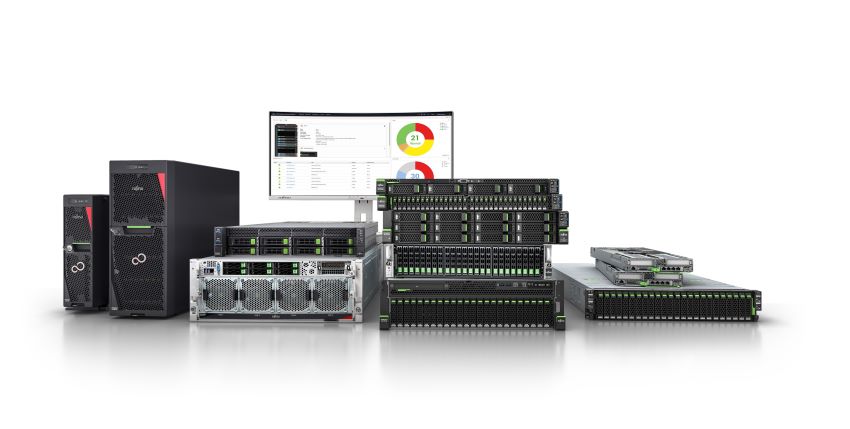
"We are using PRIMERGY servers for more than 15 years without downtime! That's what I call quality!"
Uros Lampret, Procurator, Our Space Appliances d.o.o.
In today's rapidly evolving business landscape, IT plays an increasingly important role in enabling organizations to stay competitive and meet their customers' demands. To keep up with the latest IT trends, companies need to have the right infrastructure in place, including servers that can handle a wide range of workloads and business demands.
PRIMERGY Server systems are an ideal solution for this purpose, delivering workload-optimized x86 industry standard servers that can meet the needs of any business. Recognizing that there is no one-size-fits-all solution, Fsas Technologies offers a comprehensive server portfolio that includes expandable tower servers, versatile rack-mount servers, density-optimized multi-node servers, and GPU servers purpose-built for AI and VDI.
All of these systems are designed to handle multiple and computing-intensive workloads, but each server is optimized for specific use cases. Whether you are a large enterprise with multiple sites or a small or medium-sized company with limited space and budget, PRIMERGY Servers can help your IT become the business enabler you have always wanted it to be. With the right choice of server, you can ensure that your infrastructure is up to date with the latest IT trends and equipped to handle whatever demands the future may bring.
Find the right server
Form Factor
Height Units
Processor Quantity
Processor Type
Memory Slots
Memory Capacity
max. Storage Drive Bays
PCIe slots
| PRIMERGY RX1330 M6 | PRIMERGY RX2530 M7 | PRIMERGY RX2540 M7 | PRIMERGY RX1440 M2 | PRIMERGY RX2450 M2 | PRIMERGY RX4770 M7 | PRIMERGY RX8770 M7 | PRIMERGY TX1310 M5 | PRIMERGY TX1320 M6 | PRIMERGY TX1330 M6 | PRIMERGY TX2550 M7 | |
|---|---|---|---|---|---|---|---|---|---|---|---|
| Chipset | Intel® C266 | Intel® C741 | Intel® C741 | System on Chip (SoC) | System on Chip (SoC) | Intel® C741 | Intel® C741 | Intel® C256 | Intel® C266 | Intel® C266 | Intel® C741 |
| Mainboard type | D4133 | D3982 | D3983 | D4130 | D4129 | D3984 | D4029 | D3930 | D4132 | D4132 | D3985-A |
| Product Type | Mono Socket Rack Server | Dual Socket Rack Server | Dual Socket Rack Server | Mono Socket Rack Server | Dual Socket Rack Server | Quad Socket Rack Server | - | Mono Socket Tower Server | - | - | Dual Socket Tower Server |
| Processor | Intel® Xeon® E-2400 processor family, Intel® Pentium® processor, Intel® Xeon® 6300P processor family | Intel® Xeon® Bronze 3xxx processor, Intel® Xeon® Silver 4xxx processor, Intel® Xeon® Gold 5xxx processor, Intel® Xeon® Gold 6xxx processor, Intel® Xeon® Platinum 8xxx processor | Intel® Xeon® Bronze 3xxx processor, Intel® Xeon® Silver 4xxx processor, Intel® Xeon® Gold 5xxx processor, Intel® Xeon® Gold 6xxx processor, Intel® Xeon® Platinum 8xxx processor1 - 2 x Intel® Xeon® Processor Scalable Family | AMD EPYC™ 9004 series processor, AMD EPYC™ 9005 series processor | AMD EPYC™ 9004 series processor, AMD EPYC™ 9005 series processor1 - 2 x AMD EPYC™ 9004 series processor | Intel® Xeon® Gold 6xxx processor, Intel® Xeon® Platinum 8xxx processor2 or 4 | Intel® Xeon® Platinum 84xxH processorsup to 8 | Intel® Xeon® E-2300 processor family, Intel® Pentium® processor | Intel® Xeon® E-2400 processor family, Intel® Pentium® processor, Intel® Xeon® 6300P processor family | Intel® Xeon® E-2400 processor family, Intel® Pentium® processor | Intel® Xeon® Bronze 3xxx processor, Intel® Xeon® Silver 4xxx processor, Intel® Xeon® Gold 5xxx processor, Intel® Xeon® Gold 6xxx processor, Intel® Xeon® Platinum 8xxx processor |
| Memory | 16 GB - 128 GB, UDIMM (DDR5) | 16 GB - 8 TB, DIMM (DDR5) | 16 GB - 8 TB, DIMM (DDR5) | 16 GB - 6 TB, DIMM (DDR5) | 16 GB - 6 TB, DIMM (DDR5) | 16 GB - 16 TB, DIMM (DDR5) | 128 GB - 32 TB, DIMM (DDR5) | 8 GB - 128 GB, UDIMM (DDR4) | 16 GB - 128 GB, UDIMM (DDR5) | 16 GB - 128 GB, UDIMM (DDR5) | 16 GB - 4.0 TB, DIMM (DDR5) |
| Memory slots | 4 | 32 (16 DIMMs per CPU, 8 channels with 2 slots per channel) | 32 (16 DIMMs per CPU, 8 channels with 2 slots per channel) | 24 (24 DIMMs per CPU) | 24 (12 DIMMs per CPU) | 64 (16 DIMMs per CPU, 8 channels with 2 slots per channel) | 128 (16 DIMMs per CPU, 8 channels with 2 slots per channel) | 4 | 4 | 4 | 16 (8 DIMMs per CPU, 8 channels with one DIMM per channel) |
| Memory protection | ECC | ECC, Memory Scrubbing, SDDC, ADDDC (Adaptive Double DRAM Device Correction), Memory Mirroring support | ECC, Memory Scrubbing, SDDC, ADDDC (Adaptive Double DRAM Device Correction), Memory Mirroring support | Advanced ECC | Advanced ECC | ECC, Memory Scrubbing, SDDC, ADDDC (Adaptive Double DRAM Device Correction), Memory Mirroring support | ECC, Memory Mirroring support, Memory Scrubbing, SDDC, ADDDC (Adaptive Double DRAM Device Correction) | ECC | ECC | ECC | ECC, Memory Scrubbing, SDDC, ADDDC (Adaptive Double DRAM Device Correction), Memory Mirroring support |
| Drives (optional) | DVD supermulti, ultraslim, SATA I | DVD supermulti, ultraslim, SATA I | LTO7HH Ultrium, 300 MB/sDVD supermulti, ultraslim, SATA ILTO7HH Ultrium, 300 MB/s, 2,500 GB, SAS 6Gb/sLTO7HH Ultrium, 300 MB/s, SAS 6Gb/s | DVD supermulti, ultraslim, SATA I | LTO7HH Ultrium, 300 MB/sDVD supermulti, ultraslim, SATA ILTO7HH Ultrium, 300 MB/s, 2,500 GB, SAS 6Gb/sLTO7HH Ultrium, 300 MB/s, SAS 6Gb/s | DVD supermulti, ultraslim, SATA I | - | - | DVD supermulti, ultraslim, SATA I | CD-RW / DVD Combo, ultraslim, SATA IIIDVD-ROM, ultraslim, SATA IIILTO7HH Ultrium, 300 MB/sDVD supermulti, ultraslim, SATA IBlu-ray Disc™ Triple Writer, ultraslim, SATA ILTO7HH Ultrium, 300 MB/s, 2,500 GB, SAS 6Gb/sLTO7HH Ultrium, 300 MB/s, SAS 6Gb/s | CD-RW / DVD Combo, ultraslim, SATA IIIDVD-ROM, ultraslim, SATA IIILTO7HH Ultrium, 300 MB/sDVD supermulti, ultraslim, SATA IBlu-ray Disc™ Triple Writer, ultraslim, SATA ILTO7HH Ultrium, 300 MB/s, 2,500 GB, SAS 6Gb/sLTO7HH Ultrium, 300 MB/s, SAS 6Gb/s |
| Accessible drive bays | 1 x 5.25/9.5mm for DVD-RW/Blu-ray | 1 x 5.25/9.5mm for DVD-RW/Blu-ray | 1 x 5.25/9.5mm for DVD-RW/Blu-ray1 x 5.25/0.4-inch for CD-RW/DVD | 1 x 5.25/9.5mm for DVD-RW/Blu-ray | 1 x 5.25/9.5mm for DVD-RW/Blu-ray1 x 5.25/0.4-inch for CD-RW/DVD | - | - | 1 x 5.25/9.5mm for DVD-RW/Blu-ray, 1 x 5.25/1.6-inch for backup devices | 1 x 3.5/1.6-inch for backup devices, 1 x 5.25/9.5mm for DVD-RW/Blu-ray1 x 3.5/1.6-inch for backup devices, 1 x 5.25/0.4-inch for CD-RW/DVD | 3 x 5.25/1.6-inchAccessible drive bays are not available in case of max. storage drive configuration3 x 5.25/1.6-inch for 1 x backup drive + 1 x ODD | 3 x 5.25/1.6-inch |
| Optional accessible drives | Not for 10x 2.5-inch HDD base unit. All possible options described in relevant system configurator. | 2x 2.5-inch hot-plug SAS/SATA rear optionUltra slim 9.5mm optical drive (optional)n/aNot for 10x 2.5-inch base unit. All possible options described in relevant system configurator. | ODD 5.25" possibleODD 5.25" NOT possibleAll possible options described in relevant system configurator. | Ultra slim 9.5mm optical drive (optional)All possible options described in relevant system configurator. | ODD 5.25" possibleAll possible options described in relevant system configurator. | 1 x 5.25/9.5mm for DVD-RW/Blu-ray All possible options described in relevant system configurator. | - | - | - | all possible options described in relevant system configurator | 3x 1.6x5.25" bays for an optical and/or backup drivesAll possible options described in relevant system configurator. |
| Storage drive bays | 4/8 x 2.5-inch hot-plug SATA/SAS or 4x 3.5-inch hot-plug or 10 x 2.5-inch hot-plug SATA/SASMax. 8x 2.5-inchMax. 4x 3.5-inch4x 2.5-inchMax. 10x 2.5-inch | up to 4 x 3.5-inch, 8 x 2.5-inch, 10 x 2.5-inch base unitup to 8x 2.5" (SFF) hot plug drives (SAS/SATA)up to 4x 3.5" (LFF) hot plug drives (SAS/SATA)up to 10x 2.5" (SFF) hot plug drives (SAS/SATA)up to 10x 2.5" (SFF) hot plug drives (SAS/SATA/PCIe SSD)up to 10x 2.5" (SFF) hot plug drives (SATA/PCIe SSD) | up to 16x 2.5-inch, 24x 2.5-inch, 10x 3.5-inch or 12x 3.5-inch base units10 x 3.5-inch hot-plug SAS/SATA12 x 3.5-inch hot-plug SAS/SATA16 x 2.5-inch hot-plug SAS/SATA16 x 2.5-inch hot-plug SAS/SATA/PCIe24 x 2.5-inch hot-plug SAS/SATA | Up to 10: 10x 2.5-inch SATA/SAS/NVMe (PCIe SSD)up to 8x 2.5" (SFF) hot-plug drives (SAS/SATA)up to 4x 3.5" (LFF) hot-plug drives (SAS/SATA)up to 10x 2.5" (SFF) hot-plug drives (SAS/SATA)up to 10x 2.5" (SFF) hot-plug drives (PCIe_NVMe) | up to 16x 2.5-inch, 24x 2.5-inch, 10x 3.5-inch or 12x 3.5-inch base units16 x 2.5-inch hot-plug PCIe/SAS/SATA SSD or 2x 2.5-inch hot-plug SAS/SATA HDD8 x 3.5-inch hot-plug SAS/SATA12 x 3.5-inch hot-plug SAS/SATA24 x 2.5-inch hot-plug SAS/SATA/PCIe8 x 2.5-inch hot-plug SAS/SATA24 x 2.5-inch16 x 2.5-inch hot-plug SAS/SATA |
2.5-inch hot-plug SAS/SATA/PCIe 2 x M.2 slots8 x 2.5-inch hot-plug SAS/SATA/PCIe24 x 2.5-inch hot-plug SAS/SATA/PCIeOptional expandable up to 16 storage drives |
up to 24 x 2.5-inch hot-plug SAS/SATA/PCIe24 x 2.5-inch hot-plug SAS/SATA/PCIe | 4 x 3.5-inch cold-plug SATA | 3.5-inch non hot-plug or 2.5-inch hot-plug SAS/SATAMax. 8x (4x + 4x) x 2.5-inch hot-plugMax. 2 x 3.5-inch non hot-plug SATA | 3.5-inch or 2.5-inch hot-plug SAS/SATAMax. 12x 3.5-inch or 24x 2.5-inchMax. 4x 3.5-inch or 8x 2.5-inch | 3.5-inch or 2.5-inch hot-plug SAS/SATA8 x 2.5-inch hot-plug SAS/SATA8 x 3.5-inch hot-plug SAS/SATA24 x 2.5-inch hot-plug SAS/SATA4 x 3.5-inch hot-plug SAS/SATAOptional expandable up to 24 storage drivesOptional expanderble up to 12 storage drivesoptional expanderble up to 32 storage drivesnot expandableoptional expandable up to 8 storage drivesoptional expandable up to 12 storage drivesoptional expandable up to 24 storage drivesoptional expandable up to 32 storage drives |
| LAN Controller | Intel® i210 onboard2 x 10/100/1000 Mbit/s Ethernet (TCP/IP acceleration) | 1 x 1 Gbit/s onboard, Dynamic LoM via OCP slot; OCPv3 compliant, Optional OCP adaptors:, 4 x 1 Gbit/s Ethernet (RJ45), 2 x 10 Gbit/s Ethernet (RJ45), 4 x 10 Gbit/s Ethernet (RJ45), 2 x 10 Gbit/s SFP+, 4 x 10 Gbit/s SFP+, 2 x 25 Gbit/s SFP28, 4 x 25 Gbit/s SFP28, 2x 100 Gbit/s QSFP28 | 1 x 1 Gbit/s onboard, Dynamic LoM via OCP slot; OCPv3 compliant, Optional OCP adaptors:, 4 x 1 Gbit/s Ethernet (RJ45), 2 x 10 Gbit/s Ethernet (RJ45), 4 x 10 Gbit/s Ethernet (RJ45), 2 x 10 Gbit/s SFP+, 4 x 10 Gbit/s SFP+, 2 x 25 Gbit/s SFP28, 4 x 25 Gbit/s SFP28, 2x 100 Gbit/s QSFP28 | Dynamic LoM via OCP slot; OCPv3 compliant, Optional OCP adaptors:, 4 x 1 Gbit/s Ethernet (RJ45), 2 x 10 Gbit/s Ethernet (RJ45), 4 x 10 Gbit/s Ethernet (RJ45), 2 x 10 Gbit/s SFP+, 4 x 10 Gbit/s SFP+, 2 x 25 Gbit/s SFP28, 4 x 25 Gbit/s SFP28, 2x 100 Gbit/s QSFP28 | Dynamic LoM via OCP slot; OCPv3 compliant, Optional OCP adaptors:, 4 x 1 Gbit/s Ethernet (RJ45), 2 x 10 Gbit/s Ethernet (RJ45), 4 x 10 Gbit/s Ethernet (RJ45), 2 x 10 Gbit/s SFP+, 4 x 10 Gbit/s SFP+, 2 x 25 Gbit/s SFP28, 4 x 25 Gbit/s SFP28, 2x 100 Gbit/s QSFP28 | Dynamic LoM via OCP slot; OCPv3 compliant, Optional OCP adaptors:, 4 x 1 Gbit/s Ethernet (RJ45), 2 x 10 Gbit/s Ethernet (RJ45), 4 x 10 Gbit/s Ethernet (RJ45), 2 x 10 Gbit/s SFP+, 4 x 10 Gbit/s SFP+, 2 x 25 Gbit/s SFP28, 4 x 25 Gbit/s SFP28, 2x 100 Gbit/s QSFP28 |
Intel® i210 onboard 10/100/1000 Mbit/s Ethernet |
Intel® i210 onboard2 x 1 Gbit/s Ethernet (RJ45) | Intel® i210 onboard2 x 1 Gbit/s Ethernet (RJ45) | Intel® i210 onboard2 x 1 Gbit/s Ethernet (RJ45) | 2 x 1 Gbit/s onboard |
| Remote Management | Integrated Remote Management Controller (iRMC S6, 1024 MB attached memory incl. graphics controller) | Integrated Remote Management Controller (iRMC S6, 1024 MB attached memory incl. graphics controller), IPMI 2.0 compatible | Integrated Remote Management Controller (iRMC S6, 1024 MB attached memory incl. graphics controller), IPMI 2.0 compatible | Integrated Remote Management Controller (iRMC S6, 1024 MB attached memory incl. graphics controller) | Integrated Remote Management Controller (iRMC S6, 1024 MB attached memory incl. graphics controller) | Integrated Remote Management Controller (iRMC S6, 1024 MB attached memory incl. graphics controller), IPMI 2.0 compatible | Integrated Remote Management Controller (iRMC S6, 1024 MB attached memory incl. graphics controller) | - | Integrated Remote Management Controller (iRMC S6, 1024 MB attached memory incl. graphics controller) | Integrated Remote Management Controller (iRMC S6, 1024 MB attached memory incl. graphics controller) | IPMI 2.0 compatible, Integrated Remote Management Controller (iRMC S6, 1024 MB attached memory incl. graphics controller) |
| USB ports |
7 (Rear: 4x 3.2 Gen1 for all base units, Front (except 10x 2.5” base unit): 2x USB 3.2 Gen1, 1x USB 3.2 Gen2(20 Gb, Type C) , Front (for 10x 2.5” base unit): 2x USB 3.2 Gen1) |
4 x USB 3.0 (2x front, 2x rear) | 5 x USB 3.0 (2x front, 2x rear, 1x internal) | 4 x USB 3.0 (2x rear, 2x front) | 5 x USB 3.0 (2x front, 2x rear, 1x internal) | 5 x USB 3.1 Gen1(USB3.0) (2x front, 2x rear, 1x internal) | 2 USB 3.1 (2x rear) | 5 (Front: 1x USB 3.2 Gen2x2(20 Gbps) Type C, 1x USB 3.2 Gen1x1(5 Gbps) / Rear:, USB 3.2 Gen2x1(10 Gbps) / Internal: 1x USB 3.2 Gen1x1(5 Gbps)) |
9 (Front: 1x USB 3.2 Gen2x2(20 Gbps) Type C, 1x USB 3.2 Gen1x1(5 Gbps) / Rear:, 6x USB 3.2 Gen1x1(5 Gbps) / Internal: 1x USB 3.2 Gen1x1(5 Gbps)) |
9 (Front: 1x USB 3.2 Gen2x2(20 Gbps) Type C, 1x USB 3.2 Gen1x1(5 Gbps) / Rear:, 6x USB 3.2 Gen1x1(5 Gbps) / Internal: 1x USB 3.2 Gen1x1(5 Gbps)) |
7 x USB 3.1 Gen1(USB3.0) (2x front, 4 x rear, 1x USB 3.1 Gen1 for backup devices) |
| Graphics | 1 x VGA (15-pin) / optional 1 x front VGA (not for 10x 2.5” base unit) | 2 x VGA (thereof 1x front optional - not for base unit with 10x 2.5” devices) | 2 x VGA (thereof 1x front optional - not for base unit with 12x 3.5” and 24x 2.5" drives) | 1 x VGA (1x rear) | 1 x VGA (1x rear) | 1 x VGA (1 x rear, 1 x front(Optional)) | 2 (1x rear display port), (1x front VGA) | 1 x Display Port (Integrated processor graphics) | 1 x VGA (15-pin) | 1 x VGA (15-pin) | 1 x VGA(1 x rear, 1 x front(Optional)) |
| Management LAN (RJ45) | 1 x dedicated management LAN port for iRMC S6 (10/100/1000 Mbit/s), Management LAN traffic can be switched to shared onboard Gbit LAN port | 1 x dedicated management LAN port for iRMC S6 (10/100/1000 Mbit/s) | 1 x dedicated management LAN port for iRMC S6 (10/100/1000 Mbit/s) | 1 x dedicated management LAN port for iRMC S6 (10/100/1000 Mbit/s) | 1 x dedicated management LAN port for iRMC S6 (10/100/1000 Mbit/s) | 1 x dedicated management LAN port for iRMC S6 (10/100/1000 Mbit/s) | 1 x dedicated management LAN port for iRMC S6 (10/100/1000 Mbit/s) | - | 1 x dedicated management LAN port for iRMC S6 (10/100/1000 Mbit/s), Management LAN traffic can be switched to shared onboard Gbit LAN port | 1 x dedicated management LAN port for iRMC S6 (10/100/1000 Mbit/s), Management LAN traffic can be switched to shared onboard Gbit LAN port | Management LAN traffic can be switched to shared onboard LAN port, 1 x dedicated management LAN port for iRMC S6 (10/100/1000 Mbit/s) |
| Trusted Platform Module (TPM) | Infineon / TPM 2.0 module, FIPS; TCG compliant (option) | Infineon / TPM 2.0 module, FIPS; TCG compliant (option) | Infineon / TPM 2.0 module, FIPS; TCG compliant (option) | Infineon / TPM 2.0 module, FIPS; TCG compliant (option) | Infineon / TPM 2.0 module, FIPS; TCG compliant (option) | Infineon / TPM 2.0 module, FIPS; TCG compliant (option) | Infineon / TPM 2.0 module, FIPS; TCG compliant (option) | TPM 2.0 module (option) | TPM 2.0 module (option) | TPM 2.0 module (option) | optional TPM |
| Power supply configuration | 1x standard power supply or 1x hot-plug power supply or 2x hot-plug power supplies for redundancy depending on model | 1 x hot-plug power supply or 2 x hot-plug power supply for redundancy | 1 x hot-plug power supply or 2x hot-plug power supply for redundancy | 1x hot-plug power supply or 2x hot-plug power supply for redundancy | 1x hot-plug power supply or 2x hot-plug power supply for redundancy | 3 hot-plug power supplies (standard) | hot-plug PSU, min. 4 / max. 6x per system | 1 x standard power supply |
1 x standard, 1 x hot-plug, 2 x hot-plug redundant (depending on Model) |
1 x standard, 1 x hot-plug, 2 x hot-plug redundant (depending on Model) | 1x non hot-plug power supply or 2x hot-plug power supply for redundancy or 2x non hot-plug power supply |
| Active power (max. configuration) | 494 W | 2,608 W | 2,608 W | 2,608.6 W | 2,608.6 W | 3,700 W | 8,298.2 W | 284 W | 477 W | 507 W | 2,758 W |
| Weight |
Standard: max.13.1 kg [17.7 kg(including RMK/CMA)] Short depth: max. 9.5 kg [13.8 kg(including RMK/CMA)] |
Std: max. 19.2 kg / Short depth: max. 16.6 kg | max. 32 kg | up to 18.9 kg | up to 34.1 kg | max. 40 kg | approx. 105 kg | up to 11 kg | up to 11.4 kg |
Floor system: max.28.8 kg Rack system: max. 25.8 kg [31.3 kg(including RMK/CMA)] |
Up to 41.9 kg |
| Rack (W x D x H) | 483 mm (Bezel) / 436 mm (Body) x 556 (including protrusion: 612) x 43 mm | 483 mm (Bezel) / 435 mm (Body) x 808 x 43 mm | 482.5 mm (Bezel) / 435 mm (Body) x 800 x 86.9 mm | 483 x 842 x 43 mm | 435 x 813 x 87 mm | 482.6 mm (Bezel) / 435 mm (Body) x 800 x 129.4 mm | 447.0 x 830.6 x 266.7 mm | - | - | 484 mm (Bezel) / 448 mm (Body) x 505 (including protrusion: 543) x 175 mm | 483 (Bezel); 448 mm (body) x 772 x 175 mm |
| DC Infrastructure Management |
Infrastructure Manager (ISM) |
Infrastructure Manager (ISM) |
Infrastructure Manager (ISM) |
Infrastructure Manager (ISM) |
Infrastructure Manager (ISM) |
Infrastructure Manager (ISM) |
Infrastructure Manager (ISM) |
Infrastructure Manager (ISM) |
Infrastructure Manager (ISM) |
Infrastructure Manager (ISM) |
Infrastructure Manager (ISM) |
| Server Management |
Infrastructure Manager (ISM), ServerView Agentless Service (SVAS), ServerView ESXi CIM Provider, ServerView Installation Manager (SVIM), ServerView embedded Lifecycle Management (eLCM) |
ServerView Agentless Service (SVAS), ServerView ESXi CIM Provider, ServerView Installation Manager (SVIM), ServerView Update Manager Express (UME) | ServerView Agentless Service (SVAS), ServerView ESXi CIM Provider, ServerView Installation Manager (SVIM), ServerView Update Manager Express (UME) | ServerView Agentless Service (SVAS), ServerView ESXi CIM Provider, ServerView Installation Manager (SVIM), ServerView Update Manager Express (UME) | ServerView Agentless Service (SVAS), ServerView ESXi CIM Provider, ServerView Installation Manager (SVIM), ServerView Update Manager Express (UME) | ServerView Agentless Service (SVAS), ServerView ESXi CIM Provider, ServerView Installation Manager (SVIM), ServerView Update Manager Express (UME) | ServerView ESXi CIM Provider, ServerView Installation Manager (SVIM), ServerView Agentless Service (SVAS), ServerView Update Manager Express (UME) | Infrastructure Manager (ISM), ServerView Agentless Service (SVAS), ServerView Installation Manager (SVIM) |
Infrastructure Manager (ISM), ServerView Agentless Service (SVAS), ServerView ESXi CIM Provider, ServerView Installation Manager (SVIM), ServerView embedded Lifecycle Management (eLCM) |
Infrastructure Manager (ISM), ServerView Agentless Service (SVAS), ServerView ESXi CIM Provider, ServerView Installation Manager (SVIM), ServerView embedded Lifecycle Management (eLCM) |
ServerView Agentless Service (SVAS), ServerView ESXi CIM Provider, ServerView Installation Manager (SVIM), ServerView Update Manager Express (UME) |
| Operating system | http://docs.ts.fujitsu.com/dl.aspx?id=d4ebd846-aa0c-478b-8f58-4cfbf3230473 | http://docs.ts.fujitsu.com/dl.aspx?id=d4ebd846-aa0c-478b-8f58-4cfbf3230473 | http://docs.ts.fujitsu.com/dl.aspx?id=d4ebd846-aa0c-478b-8f58-4cfbf3230473 | http://docs.ts.fujitsu.com/dl.aspx?id=d4ebd846-aa0c-478b-8f58-4cfbf3230473 | http://docs.ts.fujitsu.com/dl.aspx?id=d4ebd846-aa0c-478b-8f58-4cfbf3230473 | http://docs.ts.fujitsu.com/dl.aspx?id=d4ebd846-aa0c-478b-8f58-4cfbf3230473 | http://docs.ts.fujitsu.com/dl.aspx?id=d4ebd846-aa0c-478b-8f58-4cfbf3230473 | http://docs.ts.fujitsu.com/dl.aspx?id=d4ebd846-aa0c-478b-8f58-4cfbf3230473 | http://docs.ts.fujitsu.com/dl.aspx?id=d4ebd846-aa0c-478b-8f58-4cfbf3230473 | http://docs.ts.fujitsu.com/dl.aspx?id=d4ebd846-aa0c-478b-8f58-4cfbf3230473 | http://docs.ts.fujitsu.com/dl.aspx?id=d4ebd846-aa0c-478b-8f58-4cfbf3230473 |
| Manufacturer warranty period | 1 year | 3 years | 3 years | 3 years | 3 years | 3 years | 3 years | 1 year | 1 year | 1 year | 3 years |
| Manufacturer warranty type | Onsite warranty | Onsite warranty | Onsite warranty | Onsite warranty | Onsite warranty | Onsite warranty | Onsite warranty | Onsite warranty | Onsite warranty | Onsite warranty | Onsite warranty Warranty conditions tbd |
| Service Lifecycle | at least 5 years after shipment, for details see https://support.ts.fujitsu.com/ | at least 5 years after shipment, for details see https://support.ts.fujitsu.com/ | at least 5 years after shipment, for details see https://support.ts.fujitsu.com/ | at least 5 years after shipment, for details see https://support.ts.fujitsu.com/ | at least 5 years after shipment, for details see https://support.ts.fujitsu.com/ | at least 5 years after shipment, for details see https://support.ts.fujitsu.com/ | at least 5 years after shipment, for details see https://support.ts.fujitsu.com/ | at least 5 years after shipment, for details see https://support.ts.fujitsu.com/ | at least 5 years after shipment, for details see https://support.ts.fujitsu.com/ | at least 5 years after shipment, for details see https://support.ts.fujitsu.com/ | at least 5 years after shipment, for details see https://support.ts.fujitsu.com/ |
| Service Weblink | http://www.fujitsu.com/emeia/products/product-support-services/ | http://www.fujitsu.com/emeia/products/product-support-services/ | http://www.fujitsu.com/emeia/products/product-support-services/ | http://www.fujitsu.com/emeia/products/product-support-services/ | http://www.fujitsu.com/emeia/products/product-support-services/ | http://www.fujitsu.com/emeia/products/product-support-services/ | http://www.fujitsu.com/emeia/products/product-support-services/ | http://www.fujitsu.com/fts/products/product-support-services/ | http://www.fujitsu.com/fts/products/product-support-services/ | http://www.fujitsu.com/fts/products/product-support-services/ | http://www.fujitsu.com/fts/products/product-support-services/ |
| PCI-Express 4.0 x16 | - | 1 x Low profile | 1 x Low profile | - | - | 4 x Full height Refer to Slot Notes. | - | 1 x Full height | - | - | 4 x Full height Note: Refer to Slot Notes. |
| Mounting Depth Rack | - | Std: 836.95 mm / Short depth: 756.95 mm | 873.1 mm | - | - | 830.6 mm | - | - | - | - | - |
| PCI-Express 3.0 x4 | - | - | - | - | - | - | - | 2 x Full height, up to 215 mm length | - | - | - |
| Floor-stand (W x D x H) | - | - | - | - | - | - | - | 180 x 313 x 379 mm | 98 (with foot stand: 193) x 400 (including protrusion: 440) x 340 (with foot stand: 360) mm | 178 x 534 (including protrusion: 548) x 448 (with feet: 457) mm | 177 x 776 x 456 mm |
| PCI-Express 4.0 x8 | - | - | - | - | - | - | - | - | - | - | 8 x Full height Note: Refer to Slot Notes. |
